Carbon Neutral Plan April 2022 – March 2025
London Ambulance Service Green Plan April 2025 – March 2029
1. Introduction
Climate change presents one of the most significant public health emergencies.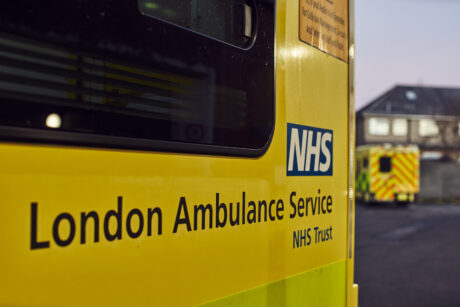
Without action and adaptation, the changes to our climate will disrupt care, and affect patients and the public at every stage of life, with poor environmental health contributing to major diseases, including cardiac problems, asthma and cancer.
NHS organisations, like the London Ambulance Service NHS Trust (LAS), have social and environmental responsibilities as public sector anchor institutions, to positively contribute to the local areas that they serve in ways beyond providing direct health care alone.
This is a social responsibility that is embedded in legislation (including the Public Services (Social Value) Act 2012), in the terms of the new NHS standard contract, and in NHSE/I national guidance.
Most recently, in October 2020 NHSE/I made the case for co-ordinated action across all NHS organisations to reduce their climate impact, setting an ambition to be the world’s first ‘net zero’ National Health Service. Two headline targets now set the requirements for all NHS organisations to be: net zero for the emissions that they directly control by 2040; and net zero for the wider emissions that they can influence by 2045.
Over the last decade, the LAS has taken some actions to reduce the environmental impact of its operations, and this has included:
- The replacement of non-ULEZ compliant vehicles with compliant models;
- The introduction of zero emissions vehicles across sections of the non-blue-light fleet;
- Increasing the proportion of calls that are responded to by Hear and Treat where appropriate;
- Improving the way that waste is disposed of to ensure that LAS waste never ends up in a landfill; and
- Ensuring that all recent construction projects meet at least BREEAM ‘Very Good’, or ‘Excellent’ classification where they are new builds.
Although progress has been made in recent years, sustainability initiatives have often not been coordinated across the organisation, and in many cases, environmental improvements may have been delivered as unintended benefits from projects that have been driven by clinical need or a requirement to improve efficiency.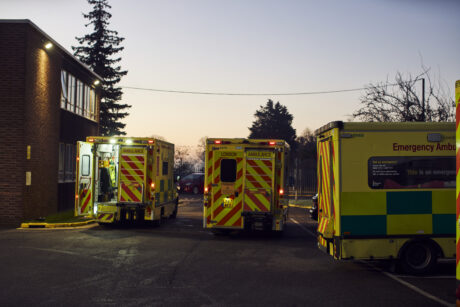
Recognising the opportunities that there are to go further and faster in reducing the environmental impact of our operations, this LAS Carbon Neutral Plan sets out our approach to deliver against our net zero targets, and outlines the specific set of initiatives that will be delivered on the first three years of that journey, to March 2025.
In accordance with national guidance, this Carbon Neutral Plan articulates specific commitments and initiatives that will be delivered across each of the six areas of focus from April 2022 – March 2025.
The plan will be updated on an annual basis to re-prioritise initiatives, where required, and to enable continued and detailed sustainability planning on a three-year time horizon.
-
1.2 . Dependencies with other strategies and policies
Strategy: Fleet Strategy
Dependency: Achievement of net zero interim targets requires LAS to transition to a fully zero-emission fleet by 2032, and this will require the first electric DCAs and blue-light cars to be brought into the service from 2024/25 at the latest.
Strategy: Estates Strategy
Dependency: To enable the delivery of a zero emissions fleet, the appropriate vehicle charging infrastructure must be in place to allow the first electric DCAs and blue-light cars to be used in active service by 2024/25 at the latest.
Achievement of net zero interim targets will also require the existing estate to be made more energy efficient and for all remaining gas boilers to be replaced with renewable sources of heating by 2032.
Strategy: Clinical Strategy
Dependency: Future refreshes of the clinical strategy should consider how changes in clinical practice may impact emissions and reduce the LAS impact on the environment, with a particular focus on reducing Entonox emissions and improving the way that clinical sharps waste is disposed of. Changes to clinical practice may require ‘trade-offs’ from our traditional delivery / response model, and these should be considered as part of any refresh.
Strategy: Digital Strategy
Dependency: Achievement of net zero objectives will require the digital technologies to enable new ways of working for clinical, support service and corporate processes, to minimise journeys, where appropriate, and make decisions based on access to comprehensive and robust sustainability datasets.
Strategy: Sustainable Procurement Policy
Dependency: Achievement of net zero across our wider footprint will require successful influence of supplier behaviour, the routine capture of supplier sustainability data, and the prioritisation of sustainability in the down-selection criteria of procurements.
Strategy: Agile Working Policy
Dependency: Achievement of net zero across our wider footprint will require staff to be able to work flexibly from different locations to minimise the need for unnecessary journeys to headquarters or another office, where this can be avoided.
Strategy: Waste Management Policy
Dependency: Achievement of net zero objectives requires LAS to reduce the waste that it generates, and to dispose of waste that is generated higher up the waste hierarchy.
-
2. The need for the LAS Carbon Neutral Plan
A number of drivers set out the case for the development and delivery of an LAS Carbon Neutral Plan. This section covers the following:
- The health impact of climate change;
- The NHS impact on the environment;
- The LAS impact on the environment;
- National policy and contractual requirements for a Green Plan; and
- London Mayor policy requirements to improve environmental sustainability.
2.1. The health impact of climate change
The Lancet Commission has called climate change ‘the biggest global health threat of the 21st century’. More intense storms and floods, more frequent heatwaves and the spread of infectious disease from climate change threaten to undermine years of health gains.
Graphic above reads:
Pollution: Pollution is the world’s largest environmental cause of premature death. Central London is one of the most polluted places in the UK and London’s air quality fails to comply with the legally binding limits set by the EU.
Heat: increased temperatures contribute to death from cardiovascular and respiratory disease. The Government’s latest UK Climate Change projections suggest London could see an increase in summer temperatures of 2.7 degrees by the 2050s. During the 2003 European heatwave, there were 75,000 extra premature deaths including 2,000 in the UK.
Infection: changes in climate are likely to lengthen the transmission seasons of vector-borne diseases. Invasive mosquitos have become widely established across Europe with outbreaks of dengue and chikungunya virus. Malaria has re-emerged in Greece and Lyme disease is already endemic across large parts of Europe – including the UK.
Weather: extreme weather patterns will directly influence health outcomes through changing exposure to heat and cold, pollen, flooding and disruption to access to health services. Pollen and other aeroallergen levels are high in extremes of heat. These can trigger asthma, affecting around 300 million people globally.
Social: Climate change also affects the social determinants of health such as secure shelter. Modelling of sea level rise projections by 2100 show that 23 per cent of London’s population would be displaced by flooding in the absence of sufficient mitigating action.
In London, we have seen wildfires at Epping Forest (2013 and 2018) and earlier this year ambulances were diverted away from Whipps Cross Hospital due to floods, following heavy rain across the capital.
The situation is getting worse, with nine out of the 10 hottest years on record occurring in the last decade and over 2,500 people killed by heatwaves in England in 2020, representing an increase of 1,600 from the year before.
Climate change also presents as a public health issue as the consequences of pollution and adverse weather disproportionately affect deprived and vulnerable communities, and in doing so, widen health inequalities. Without accelerated action, climate change will increasingly threaten the foundations of good health, with direct and immediate consequence for patients, the public and the NHS.
2.2. The NHS impact on the environment
As the largest employer in the UK, the impact that the NHS has on the environment is enormous.
The NHS produces around 22.8 million tonnes of carbon emissions each year which accounts for 25% of national public sector emissions, and 4% of the UK’s overall carbon footprint.
In 2008, the Climate Change Act set national targets for the reduction of carbon emissions in England, against a 1990 baseline. Since then, considerable progress has been made in reducing the NHS carbon footprint, with a 62% reduction in emissions in 2019 which exceeds the 37% requirement for 2020 which is outlined in the Climate Change Act.
Although significant progress has been made, the targets set out in the Climate Change Act do not cover the full scope of emissions that are generated from the NHS, and new NHSE/I guidance proposes that a wider scope of emissions should be used to monitor and measure the environmental impact of all NHS organisations.
To reduce the size of the NHS Carbon Footprint, and the wider NHS Carbon Footprint Plus, coordinated action is required by all NHS organisations across a wide range of emissions sources, including:
- Transitioning from fossil fuels to renewable power to light, heat and cool NHS estate;
- Transitioning to cleaner, emissions-free fleet and corporate vehicles;
- Reducing the waste that is generated, and re-using or recycling to minimise the waste that is sent to landfill;
- Reducing the environmental impact of carbon-intensive anaesthetic gases;
- Reducing the negative environmental impact generated across the supply chain; and
- Increasingly delivering front-line and support services remotely to reduce the emissions related to face-to-face services.
- Analysis carried out by NHSE/I suggests that while the greatest environmental gains can be made in hospitals, change will be needed across every setting of care.
Analysis carried out by NHSE/I suggests that while the greatest environmental gains can be made in hospitals, change will be needed across every setting of care.
The largest sustainability opportunities for the ambulance sector relate to their fleet, use of anaesthetic gases, business services and non-medical equipment.
2.3. The LAS impact on the environment
2.3.1. NHS Carbon Footprint
Every year, the London Ambulance Service contributes an estimated 52,971 tonnes of carbon emissions, which includes c.30,554 tonnes of carbon emissions that we directly control through our fuel, electricity, gas, water, waste and Entonox.
Around 36% of our NHS Carbon Footprint emissions are generated by our fleet where we use over four million litres of diesel fuel every year.
Although the volume of emissions fell in the early 2010s, the LAS Carbon Footprint has remained consistent at around 19,000 tonnes of carbon emissions for much of the last 4 years.
A national baselining of ambulance sector Entonox use in 2020 evidenced that LAS generated c.3,371 tonnes of carbon emissions from the use of Entonox gas in that year. This represents the highest level of emissions from Entonox gas of any of the UK ambulance services that responded to the baselining exercise. It also represents the second highest use of Entonox gas per face-to-face (F2F) contact, at 11.7 litres per contact, against a UK average of 9.
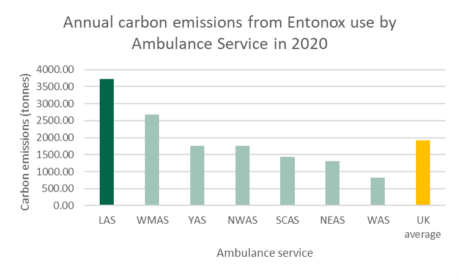
2.3.1.2. NHS Carbon Footprint: Waste
In addition to the emissions that are generated by fuel, electricity, gas, water and Entonox, the NHS Carbon Footprint also captures the emissions that are generated from waste.
According to the waste hierarchy, organisations should first prevent and re-use products to avoid the generation of waste altogether. Where this is not possible, and waste is generated, it is most preferable to recycle, then to burn and recover the energy. The least environmentally preferable methods of waste disposal are incineration and disposal at landfill.
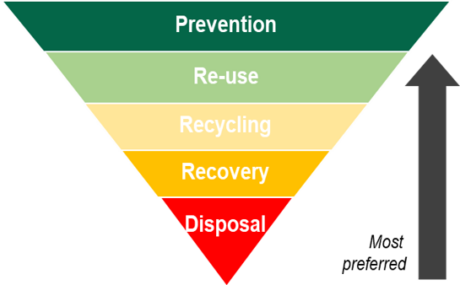
LAS waste data shows that the proportion of waste that is burned for energy recovery and recycled, has remained constant at around 57% and 40%. This accounts for the majority of our waste.
Clinical sharps cannot currently be burned for energy recovery or recycled, and must instead be incinerated. On average this accounts for 3% of total LAS waste, but accounts for 100% of our waste based carbon emissions. In the two years before the pandemic, the volumes of clinical sharps waste that were incinerated were 47,900Kgs (2018) and 48,730Kgs (2019), but this fell in 2020 to 26,600Kgs.
2.3.2. NHS Carbon Footprint Plus
There is not currently a tool that can reliably calculate the NHS Carbon Footprint Plus, and this makes it difficult to fully understand the wider drivers of LAS emissions, and how these compare to ambulance service peers.
Alternative tools like the Higher Education Supply-Chain Emissions Tool (HESCET), which have been designed to calculate the emissions of organisations in other sectors, estimate that the size of LAS scope 3 emissions is equivalent to 22,500 tonnes of carbon emissions each year. Although the tool can generate a high-level overall emissions estimate, the categorisation of emissions by driver has limitations for LAS due to its design for another sector, and because of this, emissions related to medical equipment and medical gases appear understated.
As the LAS Carbon Neutral Plan is updated on an annual basis, latest environmental sustainability baselining tools should be reviewed to ensure that the drivers of scope 3 emissions (the NHS Carbon Footprint Plus) are better understood and to ensure that activities are prioritised on the areas where they will have the biggest impact.
2.4. National policy and contractual requirements for a Green Plan
In October 2020, NHSE/I published ‘Delivering a ‘Net Zero’ NHS’, the headline national guidance for environmental sustainability across the NHS which sets out two headline commitments for all NHS organisations to be:
- Net zero for the emissions that they directly control by 2040, with an interim target of an 80% reduction by 2028-32; and
- Net zero for the emissions that they can influence by 2045, with an interim target of an 80% reduction by 2036-39.
Alongside the publication of Delivering a Net Zero NHS, new environmental sustainability clauses were introduced to the NHS standard contract which require all NHS organisations to have a Board approved green plan setting out the steps that the organisation will take to move towards national net zero targets over a three-year time horizon.
In addition to these NHSE publications and contractual changes, a number of additional national documents frame the requirements of the LAS Carbon Neutral Plan. These are listed below:
National Legislation
- Environmental Protection Act (1990)
- Civil Contingencies Act (2004)
- Climate Change Act (2008)
- Public Sector (Social Value) Act (2012)
- UK Emissions Trading Scheme (UK ETS) (2021)
National Publications
- The Stern Review 2006: The Economics of Climate Change (2006)
- Sustainable Procurement: Government Buying Standards (GBS) (2012)
- Health Protection Agency: Health Effects of Climate Change in UK (2012)
- Clean Growth Strategy (2017)
- A Green Future: Our 25 Year Plan to Improve (2018)
- UK Climate Emergency (2019)
- Net Zero: The UK’s contribution to stopping global warming (2019)
- Government’s Covid-19 Recovery Strategy (2020)
NHS Publications
- NHS Carbon Reduction Strategy (2009)
- The Marmot Review (2010)
- The Carter Review (2016)
- The Naylor Review (2017)
- Public Health Outcomes Framework (2019)
- NHS Long Term Plan (2019)
- Delivering a Net Zero NHS (2020)
- NHS Standard Contract (2020/21)
2.5. London Mayor requirements to improve environmental sustainability
Within the Capital, air pollution is one of the most significant challenges affecting the health of all Londoners.
Every year in London, 9,400 premature deaths are attributed to poor air quality at a cost of £1.4-3.7bn a year to the NHS. Road transport is the biggest source of the emissions damaging health in London. Around half of the emissions of oxides of nitrogen which contribute to illegal levels of nitrogen dioxide and particulate matter come from transport. These pollutants make chronic illnesses worse, shorten life expectancy and can damage lung development.
In 2019, Transport for London (TfL) introduced the Ultra-Low Emissions Zone (ULEZ) within the congestion charging zone to help improve air quality in central London. During the implementation of the ULEZ, TfL agreed to waive the ULEZ daily charges and Penalty Charge Notices for LAS vehicles to enable emergency vehicles to enter the charging zone, until October 2023. In October 2021, the ULEZ zone expanded to cover a larger footprint which includes all roads up to the North and South Circular, impacting a much larger proportion of the fleet. LAS compliance with Ultra-Low Emissions Vehicles (ULEV) is currently at 69% for double-crewed ambulances (DCAs) and 59% for the remaining fleet.
This falls behind the performance of other blue light services across the Capital, where Metropolitan Police Service compliance for emergency response, protection and general purpose vehicles was 71%, 85% and 98% respectively in 2019.
LAS will face increasing levels of fines if non-compliant vehicles continue to operate in the ULEZ, starting with a £2.6m fine for 2023/24 and rising to £19.3m in 25/26 for the entire non-compliant fleet.
A revised emissions strategy is expected from the Greater London Authority in late 2021 which accelerates the roadmap to the Zero Emission Zone (ZEZ) to accelerate delivery of the 2018 Mayor’s Transport Strategy, and to support the Mayor of London’s 2021 manifesto ambition for London to be carbon net zero by 2030.
Based on current information, the Zero Emission Zone is expected to start to impact LAS from 2025.
2.6. Our requirement to adapt to a changing climate
Our plan must also consider the risks that the changing climate presents to our operations. In the past ten years, we have experienced extreme weather across the Capital including heatwaves and temporary flooding, and these events have required us to work differently both in the way that we provide our services, and the way that we work with health and care partners.
The LAS HART team undergoes specialist emergency training for many disciplines including rescuing in swift water and flood environments, and as part of our mutual aid agreement with other ambulance services, we may also be required to deploy resources to other parts of the country to assist with the response to extreme environmental events when they occur elsewhere.
LAS must continue to ensure that it is well equipped to deal with extreme environmental events as they increase in frequency and severity. LAS must also consider the changes that may be needed to its assets and infrastructure to ensure resilience in the face of a changing climate, including extremes of temperature and adverse weather events. Modelling by Climate Central forecasts that much of central London is at risk of flooding by 2030 and the locations most at risk include many of our central London premises.
LAS plans for the adaptations that are required to ensure that environmental changes do not affect our ability to deliver a world class service will be captured as a guiding principle that shapes the LAS Estates Strategy (currently in development and scheduled for review by the London Ambulance Service NHS Trust Board in Summer 2022).
Figure 9: Areas of London forecast to be at high risk of flooding by 2030, from Climate Central
-
3. Delivering a Greener LAS
LAS recognises the need to go further and faster in reducing the negative environmental impacts of its services to reduce the health impacts of the climate emergency, and to meet both the ULEZ targets of the Greater London Authority, as well as the net zero and interim targets set by NHSE/I through ‘Delivering a Net Zero NHS’.
The achievement of a net zero LAS will require co-ordinated and sustained activities over the next 20 years. Large-scale multi-year changes, like estates improvements and the transition to a zero emission fleet, will be crucial, as will the continued commitments from staff to adopt changes in behaviour that reduce waste and promote ways of commuting and working that have a lower environmental impact.
Figure 10 describes the sources of LAS direct emissions, and the actions that are required to reach carbon net zero.
The most significant reduction in LAS carbon emissions will come from the transition from a fuel based fleet to a zero-emissions fleet. To meet the interim target of an 80% reduction in emissions by 2032, LAS must begin procuring zero emissions vans, Non-Emergency Transport Service (NETS) and support vehicles from 2022, and zero emissions double-crewed ambulances (DCAs) and blue light cars from 2024 at the latest, based on a replacement cycle of 10 and 7-years, for each group of vehicles, respectively.
Achievement of the interim and overall net zero targets will also require LAS to remove all gas boilers and replace them with electric or renewable alternatives by 2032. A transition away from gas boilers will require the energy efficiency of the existing estate, and building fabric, to first be upgraded to reduce energy wastage, thereby making the transition more affordable and reducing pay-back periods.
There is not yet sufficient technology to mitigate the majority of emissions that relate to Entonox and the incineration of clinical sharps. National guidance suggests that where this is the case, residual emissions should be bridged by research and innovation, and where this does not deliver results, to consider offsetting and mechanisms to secure negative emissions.
It is the expectation of this plan that the size of the LAS footprint requiring research, innovation and off-setting will reduce in future annual refreshes of this plan as uncertainty is replaced by technological innovations.
It is not yet possible to create a pathway to net zero for the wider LAS carbon footprint as there is currently insufficient data to model a realistic baseline. Appendix A
describes the initiatives that will be delivered to collect supplier and staff commuting emissions data over the next 3 years. This will enable a pathway to net zero for the LAS wider carbon footprint to be modelled by 2025.Delivery of the pathway to net zero will require a number of critical milestones to be met over the next decade. These critical milestones are described in Figure 11 below.
3.1. Areas of focus
The overall vision, priorities and actions that are required to deliver net zero for LAS are broken down by this plan into six areas of focus.
Each of the six areas of focus address different components of the LAS carbon footprint.
The heat map in Figure 13 below illustrates the impact that each of the areas of focus will have on different emissions sources within the NHS Carbon Footprint and NHS Carbon Footprint Plus. The heat map demonstrates that achievement of net zero will require all areas of LAS to contribute to the reduction in emissions in their own way.
The remainder of this chapter covers each of the six areas of focus, in turn. For each area, the Carbon Neutral Plan articulates the sustainability priorities which will reduce the associated emissions of that area.
A list of sustainability achievements for each area of focus will also recognise the initial steps that have already been taken to reduce emissions in recent years.
3.2. Clinical operations
The ‘Delivering a Net Zero NHS’ publication sets out the need for clinical operations to become more environmentally sustainable. According to data in the report, 25% of NHS emissions are generated by medicines, and in particular from anaesthetic gases. Capturing and destroying nitrous oxide could cut over one-third of NHS anaesthetic emissions, and deliver a 75% reduction in nitrous emissions.
The publication also reinforces the case that is made in the NHS Long Term Plan for delivering more sustainable, digitally-enabled models of care that are closer to home. Optimising the location of care ensures that patients interact with the service in the most appropriate setting, and this not only creates benefits for patient experience, but in many cases, may also reduce emissions related to unnecessary hospital visits and admissions.
Responding to the opportunities identified by national guidance, we will focus action to improve the sustainability of our clinical operations in four main areas, described below:
- Reducing the number of journeys to deliver care, where clinically appropriate. Using remote interventions to reduce overall journeys, and reviewing operational procedures to reduce secondary journeys and multiple attendance ratios, where clinically appropriate.
- Reducing the environmental impact of anaesthetic gases. Exploring options to reduce emissions and waste relating to the use and disposal of medical gases, where clinically appropriate.
- Reducing volumes of clinical waste. Reducing the generation of clinical waste, where possible, and disposing of clinical waste higher up the waste hierarchy when it is generated.
- Ensuring our people are equipped to respond to the challenges of a changing climate. Adapting clinical training to ensure that staff and volunteers are equipped to respond to patients affected by extremes of weather (e.g. heatwaves, floods etc.)
3.2.1. Achievements to date and in progress
Although there has not been a dedicated LAS sustainability programme, a number of improvements have delivered environmental benefits in recent years.
Some recent examples include:
- Increasing Hear & Treat – the proportion of LAS patients having a Hear & Treat outcome has increased from c. 6% in 2018 to above 10% in 2020, and this increase in remote activity will have reduced the emissions that would otherwise have occurred from delivering a face-to-face service
- Stroke video testing – the testing of video conferencing with stroke physicians in NCL helped to ensure that patients received the right care in the right place, and this will likely have had a positive impact on the emissions that would otherwise have occurred from avoidable secondary transfers
- Control room video functionality – introducing video conferencing functionality into both control rooms through the GoodSAM app supports hear and treat, and decision-making for critical care resource dispatch
- Controlled drugs (CD) supply chain – by relocating the Trust’s CD supply from Frimley to Lewisham, we will be reducing the distance of distributing medicines to stations
- Medicines packing model – by reducing the operating hours of the medicines packing unit from being a 24-hour service to running from 6am-10pm, we expect that we will reduce electricity
consumption to light and heat the medicines packing unit throughout the night - Reduction in ATP swabbing – previously hundreds of swabs per week were taken from ambulance vehicles, however following a quality review, the vehicle prep team have been
instructed to cease this practice which uses non-biodegradable components.
3.3. Estates, facilities and utilities
The NHS estate and its supporting facilities services – including primary care, trust estates and private finance initiatives – comprises 15% of the total NHS carbon emissions profile.
The ‘Delivering a Net Zero NHS’ report highlights significant opportunities for emissions reductions in these areas, with an emphasis on energy use in buildings, waste and water, and new sources of heating and power generation.To ensure alignment with the best practice and guidance from the Greener NHS national programme, we will focus sustainability initiatives in the following areas of our estate, facilities and utilities:
- Priority Net Zero Area: Improving the sustainability of our estate. Ensuring that all new buildings and major redevelopments are BREEAM Excellent, and all major refurbishments meet BREEAM Very Good. Using construction and engineering solutions to upgrade existing buildings by, for example, supporting a switch to LED lighting, and upgrading heating, cooling, building fabric, insulation, ventilation and hot water. This includes a specific requirement to eliminate gas boilers across our estate by 2032 at the latest.
- Priority Net Zero Area: Switching to 100% renewable sources of energy. Transitioning to a renewable energy tariff, and investing in on-site renewable energy generation.
- Priority Net Zero Area: Improving our waste sustainability. Reducing the generation of waste, where possible, and disposing of waste higher up the waste hierarchy when it is generated.
3.3.1 Achievements to date
Although there has not historically been a dedicated sustainability programme, the Trust has made progress in becoming more environmentally sustainable in recent years, with particular highlights including:
- Sustainability in new builds – the new Logistics Support Unit and Medicines Packing Unit have been designed according to BREEAM ‘excellent’ standards and include features such as recycled tarmac, photovoltaic panels, electric vehicle charging points, rainwater harvesting, new trees, wetland, and bee hives to enhance the biodiversity of the site.
- Building Management Systems – Building Management Systems have been installed across new facilities, which will enable the remote management of heating, ventilation and air
conditioning in the future - LED lighting – LED lights and motion sensors have been fitted during recent building upgrades
- Water efficiency – as part of renovation works, push taps and low-flow toilets have been installed to reduce water use and wastage
- Consolidation of office space – by introducing a hot-desk system and stacking plan at our Headquarters, we have been able to consolidate our corporate office space which has reduced
the requirement to heat, light and cool addition premises. - Zero waste to landfill – through supplier changes and engagement we no longer send waste to landfill. Instead, the majority of waste is sent for energy recovery (55%) and recycling (40%)
- Recycling – for many years, a system has been in place for recycling paper, card, plastics, batteries, and in some buildings food; with posters to encourage and educate staff.
3.4. Fleet and staff transport
Approximately 3.5% (9.5 billion miles) of all road travel in England relates to patients, visitors, staff and suppliers to the NHS, contributing around 14% of the system’s total emissions. This includes approximately 4% for business travel and fleet transport, 5% for patient travel, 4% for staff commutes and 1% for visitor travel.
As an ambulance service, the proportion of emissions relating to our fleet is enormous. Each year, we generate over 10,500 tonnes of carbon emissions from over four million litres of diesel fuel, and this represents over 55% of our overall NHS Carbon Footprint emissions.
Successfully transitioning to a zero-emissions fleet of vehicles, is fundamental to ensuring the delivery of our net zero objectives. In recognition of the requirement to move quickly to a zero-emissions fleet, and to support staff with their own green choices for commuting, the LAS Carbon Neutral Plan will focus sustainability activity across the following areas of our fleet and transport:
- Priority Net Zero Area: Ensuring ULEZ compliance. Transitioning our remaining non-compliant fleet to a fully ULEZ-compliant fleet by October 2023 to meet the deadline set by the Greater London Authority
- Priority Net Zero Area: Transitioning to, and sustaining, a zero emission fleet. Delivering front-line, support and corporate services from a zero-emissions fleet, and establishing the supporting infrastructure required to sustain this.
- Priority Net Zero Area: Supporting staff to make greener commuting choices. Supporting staff to adopt greener methods of commuting by, for example, ensuring that sufficient showers, bike racks and lockers are in place, and through the provision of EV charge points for the personal vehicles of our staff.
3.4.1. Achievements to date
Environmental sustainability has been a fundamental driver for LAS fleet modernisation over the last 3 years.
Significant initiatives and benefits delivered over recent years include:
- Project Zerro and Next Generation Ambulance – through Project Zerro we are developing one of the first ever hydrogen-range-extended electric double-crewed ambulances (eDCA), and through the Next Generation Ambulance project we are working with national partners to enable the national procurement of eDCAs from 2022.
- ULEZ compliance – 68% of the Trust’s front-line DCAs, and 59% of the remaining fleet, are currently ULEZ compliant
- Electric vehicles – the first fully-electric vehicles (Nissan Leafs) have been used in our supporting fleet and maternity fleet since 2018/19
- Hybrid vehicles – hybrid vehicles are used in our resuscitation and logistics fleet to deliver frontline and support services
3.5. Procurement and Supply Chain
‘Delivering a Net Zero NHS’ makes a strong case for the role that procurement and the supply chain must play in reducing NHS organisations’ carbon footprints in three main areas: more efficient use of supplies; low-carbon substitutes and product innovation; and by ensuring suppliers are decarbonising their own processes.
To ensure that all NHS organisations are able to meet the target of (carbon) net zero by 2045, headline national guidance sets out a commitment that ‘before the end of the decade, the NHS will no longer purchase from suppliers that do not meet or exceed NHS net zero commitments.’
The NHS Supply Chain is also making positive steps towards supporting sustainability, with a mandatory ‘social value’ weighting of 10% across all NHS procurements, coming into force in April 2022.
This will increase the focus on sustainability and decarbonisation across the procurement of all goods and services.
To ensure alignment with national guidance, and to realise the opportunities identified by sector best practice, we will improve the sustainability of our procurement practices and supply chain in three main areas:
- Priority Net Zero Area: Encouraging decarbonisation of suppliers. Updating LAS procurement practices to recognise and reward sustainable suppliers.
- Priority Net Zero Area: Supporting product or service innovation. Identifying common products or services that have the largest sustainability improvement opportunities (for instance, relating to a reduction in single-use plastics), and engaging with suppliers to innovate and develop greener alternatives.
- Priority Net Zero Area: More efficient distribution and use of supplies. Ensuring that supplies are distributed and used across the organisation in a way that reduces waste, and reduces emissions.
3.5.1. Achievements to date
The LAS procurement department have a Sustainability Lead, as well as a Sustainable Procurement Policy, which has enabled sustainable procurement initiatives and achievements to be realised in recent years, including:
- Plastic reduction in HQ – Eliminating single-use plastic cups, cutlery and coffee stirrers in our Waterloo Headquarters
- New Logistics Support Unit (LSU) – the establishment of a centralised and larger LSU will enable LAS to procure and store a larger supply of equipment and consumables and this will
enable a reduction in the frequency of deliveries that is required - Redistribution of stock – the Trust works closely with NHS Supply Chain and local NHS partners, identifying where surplus stock or items approaching expiry dates can be redistributed
within the wider health and care system.
3.6. Digital
Several national publications make the case for the role that digital must play in delivering net zero, including: the NHSE/I ‘Delivering a Net Zero NHS’ publication, NHSX’s ‘What Good Looks Like’ guidance, and the UK Government ‘Sustainable ICT and Digital Services Strategy (2020 to 2025)’.
To ensure alignment with national guidance, and to realise the opportunities identified by sector best practice, we will use digital to deliver our net zero objectives in three areas:
- Priority Net Zero Area: Using digital as a sustainability enabler. Digital technologies, like video functionality or supporting applications which enable increased remote functionality, are an important enabler to reduce emissions related to avoidable staff journeys.
- Priority Net Zero Area: Improving the environmental sustainability of IM&T operations. Initiatives which reduce the electricity consumption of our
IM&T infrastructure and reduce waste are necessary to deliver a sustainable IM&T department. - Priority Net Zero Area: Collecting and using sustainability data. We will begin collecting and analysing sustainability data to support evidence-based decision-making around future sustainability initiatives.
3.6.1. Achievements to date
Although there has not been a dedicated digital sustainability programme, a number of recent projects have delivered significant environmental benefits for LAS. Some recent examples include:
- Mobilising remote working – in response to the pandemic, corporate staff were provided with laptops and the supporting IT infrastructure to enable home-working. This resulted in a
reduction in emissions related to staff commuting, and a reduction in office waste. - Rolling out Electronic Patient Care Records (ePCR) – in April 2021, we rolled out iPads and ePCR to front-line clinicians to enable remote access to read and record patient data,
and this reduced the requirements to continue using paper reports. - Beginning the migration to the cloud – LAS have migrated to NHS secure O365 to exploit cloud storage and this has started the consolidation of energy-intensive, LAS-hosted data
centres.
3.7. People, culture and communications
Staff engagement is a crucial enabler for the successful delivery of the LAS Carbon Neutral Plan and to ensure that LAS can meet its net zero objectives. All staff have a role to play in making sustainable choices and living out sustainable behaviours.
Learning from good practice in other organisations, we will deliver a number of sustainability initiatives across three priority areas covering our Communications, and People & Culture Directorates:
- Priority Net Zero Area: Raising awareness of sustainability. Using communications channels to raise awareness of sustainability drivers and initiatives across the organisation and with external partners
- Priority Net Zero Area: Supporting behavioural change. Encouraging LAS people to adopt more sustainable behaviours and get involved with sustainability initiatives.
- Priority Net Zero Area: Enabling sustainability through our corporate operations and processes. Reducing the environmental impact of our corporate operations and processes by supporting staff to work remotely, where possible, and reducing the generation of waste.
3.7.1. Achievements to date
Despite not having an overarching sustainability programme across the Trust, many staff are enthusiastic and passionate about reducing our negative environmental impact. A number of recent initiatives and achievements have been delivered from both the self-organisation of motivated individuals, and central teams, including:
- Staff led recycling – a scheme for recycling crisp packets was recently introduced by a member of staff, which is additional to the Trust-managed recycling infrastructure
- ‘Go Walk’ campaign – the Trust ran a campaign encouraging staff to get active (drive less, walk more) by providing free pedometers and running a step counting competition
- Staff gardens – the Communications team run an annual competition to encourage staff to look after the green spaces within their stations
-
4. Ensuring delivery of the LAS Carbon Neutral Plan
Delivery of our net zero objectives requires sustained and co-ordinated activity across the whole of the LAS over the next 20 years. Regular monitoring and reporting on delivery progress will be crucial to ensure that yearly progress is sufficient for the achievement of objectives that are decades into the future.
4.1.Monitoring and Reporting on Sustainability Progress
Historically, LAS has not had an organisation-wide forum to review sustainability initiatives, coordinate activities and monitor progress. Governance for the delivery of the Carbon Neutral Plan will be agreed following the guidance arising from the Good Governance Institute audit being carried out in winter 2021.
The governance structure for sustainability will provide assurance on the implementation of sustainability initiatives and organisational progress against net zero targets through to Trust Board via the Executive Committee. Rather than establishing a new and separate committee, it is likely that the governance for sustainability reporting will be captured within the terms of reference of an existing LAS committee.
4.2. Trust Board-level accountability for sustainability
The Chief Financial Officer will be the Board-level Sustainability Lead for the London Ambulance Service, and will be ultimately accountable for the successful delivery of the LAS Carbon Neutral Plan and achievement of net zero objectives.
4.3. Building sustainability capability and capacity
The development of the LAS Carbon Neutral Plan has identified many examples where specialist sustainability expertise would be value-adding, and where dedicated sustainability delivery resource could bridge the gap across initiatives that span multiple directorates. This includes:
- Contributing expertise to support the modelling of an emissions trajectory based off of agreed Carbon Neutral Plan initiatives;
- Understanding opportunities to use more sustainable products across our operations; and
- Supporting the technical evaluation of supplier sustainability responses to ITTs.
Without specialist expertise and dedicated delivery support, there is a risk that initiatives may not be delivered and that the sustainability benefits of the Carbon Neutral Plan will not be fully realised.
In recognition of this risk, and to improve our capability and capacity to successfully deliver the Carbon Neutral Plan, we will establish and recruit to a Sustainability Manager post. The Sustainability Manager will be responsible for:
- Leading the annual updating of the Carbon Neutral Plan and sustainability section of the
Annual Report; - Collecting and submitting quarterly Greener NHS data returns;
- Providing expertise and delivery capacity for a number of Carbon Neutral Plan initiatives;
- Mobilising and co-ordinating a network of eco-champions;
- Inputting into sustainability funding applications;
- Reviewing and monitoring changing legislation and compliance requirements;
- Networking with green leads in London and across the ambulance sector; and
- Leading on sustainability engagement with internal and external stakeholders.
4.4. Funding approach to deliver the LAS Carbon Neutral Plan
To fully deliver the LAS Carbon Neutral Plan and meet net zero targets, significant capital investment must be made to upgrade and transform the LAS estate and fleet. For example, the cost of decarbonising our DCA fleet is likely to be in excess of £86.8m. The investment required to decarbonise our estate will emerge as the Estates Strategy is developed during 2022. This scale of transformation will require multi-year financial commitment to prioritise sustainability improvements across the next decade.
Investment decisions for large capital projects will be planned and assessed through the Trust’s usual business case and business planning processes. As part of this, the feasibility and affordability of projects will be assessed. A number of initial business cases for the LAS Carbon Neutral Plan have been identified. These business cases will be written over the
next 18 months, and predominantly relate to fleet replacement, energy efficiency and building fabric upgrades.Successful approval and delivery of the business cases will be dependent upon the availability of sufficient capital. To deliver at the pace that is required, LAS will need to bid for capital from external funding schemes as internally-generated capital funding will not be sufficient to fully deliver the Carbon Neutral Plan alone.
A number of sustainability-focussed funding schemes have been established in recent years to support organisations, like the LAS, in decarbonising. The largest of these funds is the Public Sector Decarbonisation Scheme which has allocated £280m in the first two phases of funding, and which will make a further £1.425bn investment to public sector bodies through to 2025.
LAS will establish a Sustainability Manager post (as described in Section 4.3) to create additional capacity and capability to develop high-quality and compelling bids for funding from sources like the Public Sector Decarbonisation Scheme. The Sustainability Manager will work closely with colleagues from the Finance Directorate, and other relevant areas of LAS (for instance, Strategic Assets and Property) to co-develop bid submissions, and this will enable Carbon Neutral Plan delivery at the pace that is required.
4.5. Risks to delivering the LAS Carbon Neutral Plan
- Risk: There is a risk that there will be insufficient capital to deliver the Carbon Neutral Plan at the pace that is required.
- Risk: There is a risk that there may be insufficient focus on delivering the Carbon Neutral Plan, particularly during periods of high operational pressure
- Risk: There is a risk that there is insufficient Board-level visibility of sustainability
- Risk 1 – Proposed mitigations: LAS will establish a Sustainability Manager post to create additional capacity and capability, alongside the Finance Directorate,
to develop high-quality bid submissions to relevant external funding schemes. - Risk 2 – Proposed mitigations: The Carbon Neutral Plan will be updated on an annual basis and progress will be reported to Trust Board to ensure that the pace of delivery
is sufficient to meet net zero targets. Establishing a Sustainability Manager role will ensure that delivery can be co-ordinated and that there is sufficient focus on sustainability across the organisation. - Risk 3 – Proposed mitigations: Regular progress in delivering the LAS Carbon Neutral Plan will be reported through to Trust Board. The specific governance route will be
informed by the recommendations of the Good Governance Institute audit.
-
5. Conclusion and immediate actions
LAS recognises its responsibility in reducing the carbon emissions and negative environmental impact of its operations.
This LAS Carbon Neutral Plan sets out the pathway to a net zero LAS by 2040 for direct emissions and 2045 for the emissions that it can influence.
5.1. Immediate next steps
Upon Trust Board signoff, a number of immediate actions are required to mobilise the delivery of the Carbon Neutral Plan.
These include:
- Sustainability Manager recruitment: to be actioned as a priority
- Sustainability Governance mobilisation: the governance section of the LAS Carbon Neutral Plan will be updated to reflect the recommendations of the Good Governance Institute
audit, and associated terms of reference will be updated to include sustainability reporting responsibilities - Communications planning: developing a sustainability communications and engagement plan outlining key messages for 21/22, key stakeholders and the channels through which they
are engaged - Green Staff Survey: promoting the Green Staff Survey to all staff before the end of Q4 21/22 to capture baseline data on staff commuting and attitudes towards sustainability
- Energy tariff options appraisal: conducting an options appraisal and developing a business case to consider switching energy tariffs to a green / renewable tariff before the renewal date
in April 2022. - Directorate operational plans: updating of operational plans by each Directorate to ensure that initiatives and actions described in the relevant areas are captured in Directorate plans


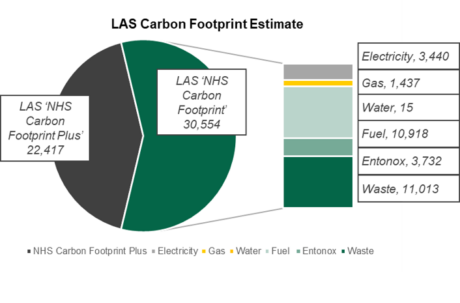
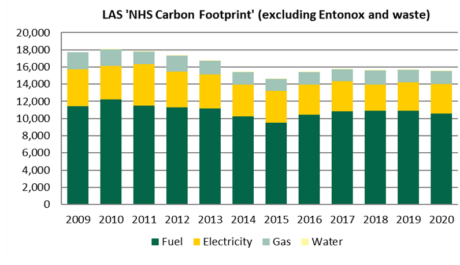
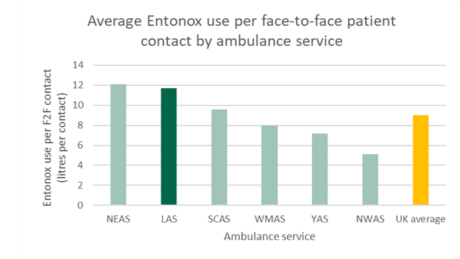

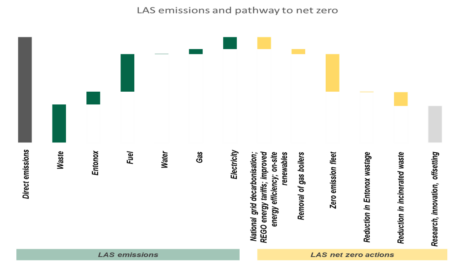
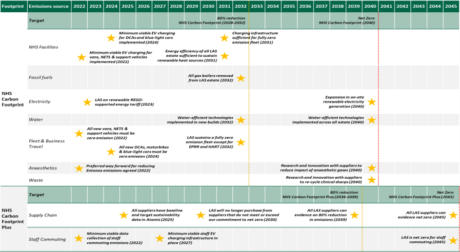
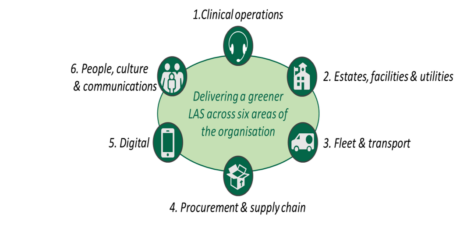
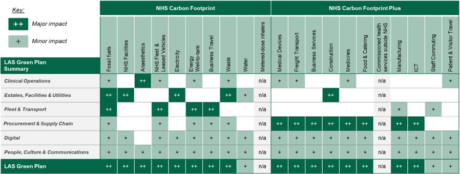
Follow us on social media: